





For many people, the greatest drawback to growing fruit in their garden is the necessity to spray, spray, spray in order to keep pests from spoiling the fruit. One solution is bagging the fruit instead.
There are many different pests that infest fruit trees, but three of the most bothersome are the plum curculio, the codling moth, and the apple maggot. These are the most responsible for the "worms" that destroy so much fruit in the home orchard. Some times, in order to harvest unspoiled fruit, the grower ends up spraying the trees as often as every ten days throughout the growing season. But this practice is objectionable for environmental reasons, so growers have been trying a number of less toxic alternatives, such as sticky traps or pheremone lures.
Bagging can be another nontoxic alternative method of protecting pome fruits such as apples and pears.
When I first heard of bagging apples, the method described was using brown paper sandwhich bags and stapling them around the stems of the growing fruits. This struck me as awfully time-consuming. Then I thought of the plastic zipper-style sandwich bags. Since I have first tried this method of bagging apples, I have been rewarded with wormless fruit, while my sprayer sits unused for most of the season. [You may still have to spray for scab or other diseases, or use insectide against, say, the rosy apple aphid if it shows up.]
The method may not entirely eliminate the need for spraying insecticide if you live, as I do, in a region where the plum curculio roams the orchard. This pest becomes active even before the petals have dropped from the trees and may attack the newly-formed apples before they are large enough to bag. Once they are bagged, however, they are pretty well safe from the worms.
Here's how it's done. First, obtain a supply of plastic zipper sandwich bags. You may need a couple hundred for every tree, so it is a good thing that the cheap generic ones will work perfectly well. They can also be saved and re-used from year to year. Then you will need a smallish pair of scissors or a small pruner - I use a nail clipper - both to thin the fruit and to cut a small slit in the bottom of each bag. This is to let water drain out, if water happens to get into the bag, which it often does.
The time to bag is after the first "June fruit drop," when the unpollinated fruit aborts, or when the fruit is at least 1 cm across - any time before the codling moth shows up in your orchard. If you hand-thin your fruit, bagging can conveniently be done at the same time.
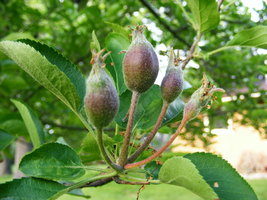
This is my Yellow Delicious apple tree. Last year was an "off" year for this tree, so this year it is heavily loaded. It will definitely need to be thinned. For each cluster of fruit, the first thing is to identify the "king" apple. This is the central fruit in the cluster and usually the most developed. It is the fruit that the tree will want to keep if it drops the rest. In this cluster, the small fruit on the right was not pollinated and is about to drop. Of the remaining three, the "king" apple is the one in the middle. Its stem is visibly thicker.
First, I check this fruit to see if it is blemished or damaged - in particular to see if it has the characteristic D-shaped egg-laying cut in its skin made by the early activity of the plum curculio. Since it does not, I remove the other fruits with my nail clippers, leaving only the "king."
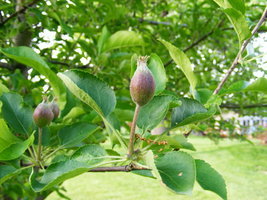
The final step is to zip the bag around the apple's stem, closing it as tightly as possible.
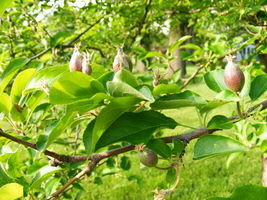
Here, there are too many clusters of fruit too close together. I will not only remove all but one fruit in each cluster, I will remove some of the clusters, leaving them no closer than six inches.

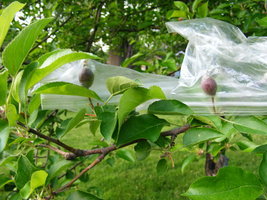
This method of bagging also works well with pears. I never used to spray my pears, as the pests didn't seem interested in them. Last year, however, the codling moths, frustrated by the bags around the apples, took it out on my pears and pretty well ruined the harvest. Below is a cluster of pears, thinned to one fruit and bagged.
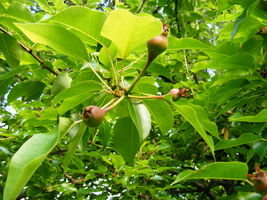
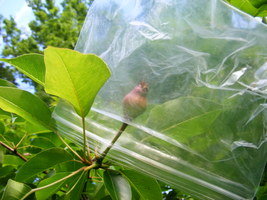
You may note that in these photos the bag appears to be upside down. As the fruit grows and becomes heavier, it will hang downward, and so will the bag.
Bagging the fruit is definitely time-consuming and labor-intensive. It is probably only practical for those of us who have small home orchards.
I do not recommend this method of bagging for stone fruit such as peaches. For one thing, most of these fruits have no stem to zip the bag around. Perhaps more important, the humidity trapped in the bag is likely to contribute to the development of brown rot. I haven't noticed this sort of problem with apples or pears. Give bagging a try, and you may find yourself cutting way back on the use of your sprayer, while harvesting worm-free fruit with no toxic pesticide residue.
Copyright © www.100flowers.win Botanic Garden All Rights Reserved